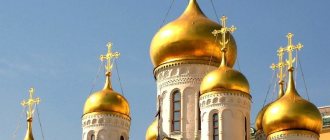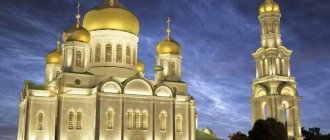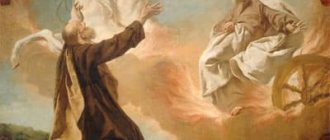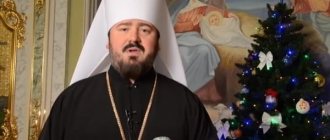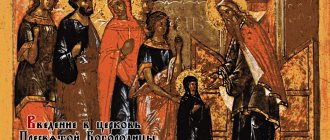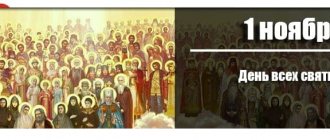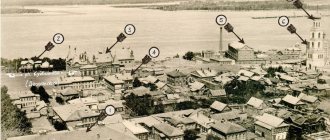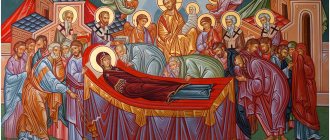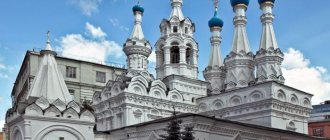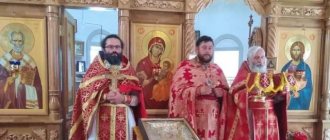January is very rich in various holidays, including church ones. Most Orthodox believe that Christmas is the most important thing. However, the day following this celebration is considered no less important. After all, on January 8, the feast of the Cathedral of the Blessed Virgin Mary is celebrated, which in the old days was much more significant for women than all Christmas services. It's no secret that in Rus' the Mother of God has always been very revered. Numerous temples, monasteries were built in her honor and icons were painted. Many of the images became miraculous and still attract the attention of thousands of pilgrims from all over the world. Today the feast of the Cathedral of the Blessed Virgin Mary is not so well known, but this does not detract from its significance. From our article you will learn about the history of the emergence and development of this celebration. And also about what the feast of the Cathedral of the Blessed Virgin Mary means for all believers and especially women.
Description of the celebration
Our ancestors always visited the temple not only on the seventh, but also on the 8th of January. The holiday of the Cathedral of the Blessed Virgin Mary has a very ancient origin and belongs to the celebrations of the main church circle. There is a tradition in Orthodoxy according to which, after some great holiday, the accompanying celebration is always celebrated. Most often, without those persons whom the church honors on this date, the great holiday simply would not be possible.
Therefore, on the feast of the Synaxis of the Most Holy Theotokos, all believers remember the Mother of God, who revealed the baby Jesus to this world. However, not only is she celebrated on this date; in parallel, Christians glorify those who were involved in the birth of Christ and helped save his life.
Who else is celebrated on January 8th?
On the Orthodox holiday of the Cathedral of the Blessed Virgin Mary, churches remember not only the Virgin Mary. In addition to Her, on this day they pray for three more personalities who are considered close to the Savior in his earthly life:
- Joseph.
- King David.
- Jacob.
Each of these names is well known to the Orthodox. For example, Joseph is called the husband of Mary, which is how he is introduced to us during the Christmas stories. However, clergy can tell a completely different story about the events preceding the birth of baby Jesus. This information relates to the background of Christmas and the feast of the Synaxis of the Blessed Virgin Mary. We will tell readers about this in the next section of the article.
Feast of the Cathedral of the Blessed Virgin Mary: history of the holiday
Ancient books mention that at the time Joseph became the betrothed husband of the Virgin Mary, he was already eighty years old. Our Lady was entrusted to him to preserve Her life and purity. Joseph was previously married and had several children. It was one of his sons, Jacob, who went with the born Savior to Egypt in order to preserve His life, as well as to save his father and Mary herself from the power of King Herod. It is noteworthy that not too much is known about Joseph. He was considered a very pious man and it was because of this that he was chosen to play the role of the man protecting the Mother of God. This became his most important service to the Lord, which Joseph went through from beginning to end.
I would like to clarify that Jacob, like his father, was very pious and after the martyrdom of Christ and his resurrection from the dead, he became the leader of one of the first Christian churches.
It is impossible not to mention King David. His name is remembered on the feast of the Council of the Blessed Virgin Mary because he is the ancestor of Christ, and they come from the same family.
If you are interested in the background of the church holiday, then the clergy talk about the miraculous salvation of the baby from the wrath of Herod. The king was waiting for the wise men who came to his lands with gifts for the newborn to reveal his location. However, they never succumbed to Herod’s persuasion and secretly left his kingdom. Enraged, he ordered his soldiers to destroy absolutely all the babies in the city of Bethlehem and its immediate surroundings. However, Joseph saw in a dream an angel sent to him with a warning. The angel commanded him to immediately get up, take his family and flee to Egypt to save their lives. Joseph followed the words he heard and was able to avoid a sad fate.
Many years later, the angel again appeared to Joseph and informed him of the death of Herod, commanding him to return to Bethlehem. The holy elder again submitted to the will from above, but he did not dare to settle in the same city where the son of the cruel king now ruled. Together with his family, Joseph went to Nazareth, where he settled.
By saving the lives of Christ and the Mother of God, he fulfilled his main purpose. Therefore, she is honored almost on a par with the Virgin Mary on the feast of the Synod of the Blessed Virgin Mary.
Cathedral of Our Lady
The beginningless begins
The day after the Nativity of our Lord Jesus Christ, January 8th, the Church established the celebration of the Council of the Most Holy Theotokos.
The name of the holiday “Cathedral” means that believers all together, collectively, glorify the Heavenly Lady, who gave birth to the Savior of the world. The great mystery has been accomplished, and the Invisible is already seen, and the Intangible is touched, and the Beginningless begins
…
The Lord was born from the Most Pure Virgin Mary incomprehensibly and ineffably, during the reign of the Roman Caesar Augustus, in the year 5508 from the creation of the world. “Obeying Caesar’s command, O Christ, You entered into the number of slaves, and made us, slaves of the enemy and sin, free.”
The Divine Infant, wrapped in swaddling clothes, was laid in an ordinary manger, which served as a feeding trough for livestock. But His Highest glory was not hidden in the darkness of the night, in the den, manger and swaddling clothes - in this first image of the humility and humiliation of the God-man. The birth of the Savior was immediately known on earth, in different countries of the world: by the shepherds of Bethlehem, and by the eastern sages-magi, simpletons and scientists.
The establishment of the feast of the Cathedral of Our Lady dates back to very ancient times. In the 4th century, some Church Fathers, for example, Saint Epiphanius of Cyprus, already spoke teachings on the day of this celebration. Let us note that in the ancient monthbooks the feast of the Synaxis of the Blessed Virgin Mary is also called “Gifts of Birth.” By gifts we meant the gifts that were brought to the newborn God-infant Jesus. The Cathedral of Our Lady was also called the "Flight into Egypt". In the ancient Church, the memory of the worship of the Eastern sages was connected with the flight to Egypt.
The iconography of the Council reflects the glorification of the Mother of God, thanks to Whom an event unheard of in the universe took place, which stood at the intersection of the Old Testament and New Testament history of mankind - the coming into the world of the Creator of the entire universe. The composition of this image is based on the text of the Christmas stichera - a hymn of gratitude performed at the evening service of the Feast of the Nativity of the Savior: “What shall we bring to Thee, O Christ, for Thou hast appeared on earth as a man for our sake? Every former creature from You brings thanksgiving to You: Angels - singing, heaven - a star, wolves - gifts, a shepherd - a miracle, the earth - a den, the desert - a manger, but we are the Virgin Mother.”
The iconography of the Cathedral reflects the glorification of the Mother of God, thanks to Whom an event unheard of in the universe took place
The icon illustrates this stichera with maximum accuracy. The images mentioned in it are united here to give thanks and bring gifts to Christ by the entire visible and invisible world.
In the center of the icon, on a high place, the Mother of God solemnly sits with Her Divine Son in her arms. Above are the angels, crying: “ Glory to God in the highest, and on earth peace, good will toward men.”
“- proclaim the fulfillment of Divine Revelation about the appearance of the Redeemer in the world.
Around the Mother of God and the Child stand the king-magi, who came for the star, and the little ones of this world - ordinary Bethlehem shepherds (shepherds), gathered with their humble sheep at the blessed den.
Evangelist Luke narrates that the earthly humiliation of the Divine Infant was accompanied by heavenly glorification: an angel appeared to the shepherds guarding the flock in the field at midnight and announced the great joy that would be for all people: for today a Savior has been born to you in the city of David
(Luke 2:10–11).
And the Gospel of Matthew says that when the Lord was born, the wise men came to Jerusalem, asking where, according to the prophecies, Christ should be born, for they saw His star in the east
.
They were pointed to Bethlehem. They went here and there, the star that they saw in the east walked before them, when it finally came and stood over the place where the Child was
(Matthew 2:9). Entering the house, the Magi saw Christ and His Mother, bowed and placed the gifts they had brought before Him. The Child depicted on the icon accepts these gifts - gold, incense and myrrh.
And in the bottom row of the icon, the Old Testament kings and prophets, as if together with choirs of angels, welcome the descent to earth of the One Whom they so ardently desired to see. Godfather David, through the darkness of distant centuries, clearly sees how foreign sovereigns greet the newborn King of kings with gifts and the peoples rush to take refuge under the shadow of His blessed kingdom: all the kings of the earth will worship Him, all the nations will work for Him
(Ps. 72:11).
Following the inspired psalms of David, the voices of the ancient prophets are heard: Micah, who foretold the birth in Bethlehem of the great leader of Israel, Jeremiah, who foresaw the East from above, coming to illuminate the universe with a new light, and especially the wondrous prophecy of Isaiah, who foresaw the miraculous birth of the God-man seven centuries ago.
Often, female figures are depicted in the lower corners of the icon, which, according to the lines of the stichera, personify the earth bringing a den, and the desert holding a manger in their hands.
At the top of the icon the Star of Bethlehem shines - a gift from heaven to the born Lord. For more than two thousand years this star has been shining for humanity, and each of us keeps its reflection in our hearts.
In the heights of heaven, many stars are burning, But one joyfully shines brighter than all. That is the star of the Child and the King of kings, He was laid in a manger by His Mother. And the wise men from the east follow the star, And bring gifts with love to the Lord. Brothers! Hurry to receive the Lord, Let us hasten to cordially give bread and salt, He will take this bread with the hands of the poor and send us a blessing for it.
Icon "Stalingrad Madonna"
During the Great Patriotic War, just as the Orthodox Church celebrates the Council of Our Lady, another image appeared throughout Western Christendom as the “Stalingrad Madonna.” It was written by a chaplain of the fascist army just before the feast of the Nativity of Christ and became a symbol of the repentance of the German people before the Creator for allowing themselves to be drawn into one of the most disgusting and bloody wars in the history of mankind, unleashed by Nazi ideology.
“The Germans and their allies - Romanians, Italians, Hungarians, Croats and many others - came to Stalingrad with the conviction that they were saving Russia from the godless communists. Few of them might have known the letter from the head of the party chancellery, Martin Bormann, sent to all Gauleiters of the Third Reich 13 days before Germany’s attack on the USSR, which contained the following words: “National Socialist and Christian worldviews are incompatible... National Socialism recognizes the forces of nature as “ omnipotence" or "God" and rejects the personified God." And, of course, they did not know about the words spoken at the meeting “on the church issue” on September 22–23, 1941 at the Main Directorate of Reich Security by Gestapo Chief Müller. He explained that it was necessary to act against church organizations in a united front: “Gruppenführer [Himmler] has finally decided that in the future there must be a complete suppression by the state police of the most dangerous of all dangerous enemies [the Church].”[1]
On the feast of the Synaxis of the Blessed Virgin Mary, I would like to talk about the image of the “Stalingrad Madonna” as evidence of another epiphany of the “twelve tongues” that the Russian people honor God and are therefore invincible.
Its author, Kurt Reuber (1906–1944), was born in 1906 into a Lutheran family. He studied theology in Marburg and became a priest in the village church in Wichmanshaus. Life brought him together with the famous thinker, musician, doctor and missionary Albert Schweitzer. On his advice, Reuber began to study medicine and received a doctorate. He was interested in issues of ethics and cultural history. Just before the war, his artistic abilities were discovered. As a pastor, Reuber openly criticized National Socialism in his sermons. How he escaped the fate of many priests - a concentration camp - is unknown.
When German Protestants celebrated All Souls' Day on November 22, 1942, Paulus's 6th Army already knew that they were surrounded by Soviet troops. Chaplain Reuber was in Stalingrad and called this date a day of "doubt, confusion and horror."
On the eve of Catholic Christmas, when fellow soldiers were dying of hunger and wounds nearby in a bunker, he decided to draw them a Christmas card as a gift on the back of a captured Russian map. And a miracle happened: an image of the Mother of God was born, which many years later became known as the “Stalingrad Madonna.”
The Mother of God, bending over the serenely sleeping Baby, tenderly holds Him in her arms. Despite the fact that it was painted by a person of Western culture, this image contains the iconographic asceticism inherent in an Orthodox icon. The omophorion covering the Mother of God and Her Divine Son is reminiscent of the Bethlehem cave, protecting them from the horrors of life and death. The whole picture carries the glow of Christmas. The inscription around it reads: “Christmas. 1942. Night in the cauldron. Stalingrad fortress. Light, life, love."
The omophorion covering the Mother of God and Her Divine Son is reminiscent of the Bethlehem Cave, protecting them from the horrors of life and death
Perhaps the decision to paint this particular image was inspired by the German chaplain’s miracle of the appearance of the Virgin Mary, which occurred in November high in the sky above Stalingrad. Russian soldiers testified that the Germans also saw the Queen of Heaven, the Intercessor of Rus', appearing in full growth in the sky to help our soldiers who were holding defense on a narrow strip of land along the steep bank of the Volga. One of the defenders of Stalingrad, who saw the appearance of the Mother of God […] spoke about this miracle: “When I saw the Mother of God in the sky, my soul was in an exalted state. It immediately became clear to me that I would not die and would return home alive. The confidence in victory never left. The vision of the Mother of God in full growth in the autumn sky of Stalingrad carried like a shield through the entire war.”[2] The warriors who saw this phenomenon retained the memory of it until the end of their days.
For the Germans, this sign from above became fatal. On the holiday itself, the chaplain’s home looked like a nativity scene. As the British historian Anthony Beevor wrote after the war in his book about Stalingrad: “Everyone who entered the dugout froze in admiration on the threshold. Many began to cry. To Reuber’s great embarrassment, his dugout turned into a place of pilgrimage on Christmas Day, where soldiers came to pray before the image of the Madonna he painted.” But it was on December 25 that the ring around the German troops closed tightly.
The Stalingrad Museum preserves unsent letters from German soldiers. These are desperate thoughts about God, life and death: “Sometimes I pray, sometimes I think about my fate. At the same time, everything seems meaningless and aimless to me. When and how will deliverance come? And what will it be: death from a bomb or a grenade? Or illness? In addition, the painful thought of home, longing for the Motherland have already become a disease. How can a person bear all this? Or is all this suffering God’s punishment?”
Reuber remained himself on the Eastern Front and painted Russian women, old people, and children. “Every face was transparent for him...” - his wife would later say, to whom one hundred and fifty images of “people of the East” had reached her. He also provided assistance to Soviet prisoners of war and treated civilians. And in his letters he told with surprise how fervently ordinary Russian people prayed in the destroyed Stalingrad.
And for the Germans, according to Kurt Reuber, there was only “fear, fear, fear without end... Attacks and counterattacks, the roar of tanks and guns, the howl of Katyushas, machine guns, grenades - and all this face to face... A soldier lay next to me with with a severed hand and no nose, who had the strength to say that he would no longer need a handkerchief. I asked him what would he do if he could cry? In response, all of us here will never cry, others will mourn us...”
On one of the last planes to escape from the Stalingrad cauldron, the wounded officer, at Reuber's request, took Madonna out as a gift to his wife. In a letter to her, full of repentance and shame for what the Germans did in Russia, he wrote: “It’s unlikely that we have any hope.”
Kurt Reuber died in Yelabuga in a camp for German prisoners of war on January 20, 1944 at the age of thirty-eight. Copies of the “Stalingrad Madonna” were distributed throughout the Western world. And the original is in the Kaiser Wilhelm Church in the center of Berlin.
I would like to believe that the German people remember the mistakes of the past.
[1] Epiphany of chaplains // Farberov A. I. Save and preserve. M., 2015. pp. 342–343.
[2] Ibid. pp. 305–306.
The formation of a church holiday
The Feast of the Cathedral of the Blessed Virgin Mary has been celebrated for a very long time; its formation occurred almost parallel to the development of the Christian Church. Around the fourth century, many clergy and holy elders wrote that at Christmas it was imperative to remember and honor the Mother of God. They taught Christians in their texts and advised them how to properly celebrate this holiday.
For many centuries, believers treated Christmas exactly as the holy men commanded them, but around the end of the seventh century, the Ecumenical Council made a different decision regarding this date. It is worth noting that the clergy participating in the Council often established rules that in the future became the norm for the entire Church. Therefore, the decision made to separate Christmas and honoring the Mother of God was perceived as a direct instruction for all Christians. Since this period, Orthodox Christians have brought congratulations on the feast of the Synaxis of the Most Holy Theotokos to each other on January 8th. To this day, this date has not changed; moreover, it is worth considering that it is constant and does not depend on other holidays, like many other church celebrations.
From this it is clear that they did not immediately go from Bethlehem to Egypt, but first went to the temple of the Lord, then to Nazareth, and finally to Egypt. Saint Theophylact also testifies to this in his interpretation of the Evangelist Matthew, when he writes: “Question: How does the Evangelist Luke say that the Lord retired to Nazareth after 40 days after His birth and after He met the elder Simeon?And here Saint Matthew says that he came to Nazareth after returning from Egypt? Answer: Know that the Evangelist Luke mentions what the Evangelist Matthew kept silent about, namely, that the Lord (says Luke) after His birth went to Nazareth. And Matthew speaks about what happened after that, namely: how our Lord fled to Egypt and how, upon returning from there, he again went to Nazareth. In general, the Evangelists do not contradict each other, but only Luke speaks about the removal of Christ from Bethlehem to Nazareth, and Matthew talks about His return to Nazareth from Egypt.” So, upon leaving the temple of the Lord, the holy travelers first went to Nazareth and immediately made orders regarding their home, and then, having captured everything they needed for the journey, hastily, at night (so that their closest neighbors would not know this) they set off along the road to Egypt. At the same time, they took with them, for service, Jacob, the eldest son of Joseph, who was later called the brother of the Lord, as can be seen from the church hymn for October 23rd (s.st.), where it is sung like this: “You have appeared as a brother, a disciple, and witness of divine mysteries, ran with him, and was in Egypt with Joseph.” From this it is clear that Jacob also accompanied the holy family on the way to Egypt, serving them during the journey.
And the Lord fled to Egypt partly in order to show that He was a true man incarnate, and not a spirit and a ghost (as St. Ephraim points out in his word on the Transfiguration when he says: “If He had not been flesh, then with By whom did Joseph flee to Egypt?" and partly in order to teach us to flee the anger and rage of man, and not proudly resist them. This is how Chrysostom explains it: “In his flight,” he said, “the Lord teaches us to give place to rage, i.e. run around human rage. And if the Almighty flees, then we, the proud, learn not to expose ourselves to danger.”
The purpose of the Lord’s flight into Egypt was also to cleanse Egypt from idols and, as Saint Pope Leo says, so that not without this country, in which for the first time the saving sign of the cross and the Passover of the Lord were foreshadowed through the slaughter of the lamb, the sacrament of the most holy sacrifice would be prepared. Also, so that the following prophecy of Isaiah would be fulfilled: “The Lord will sit on a light cloud and come to Egypt. And the idols of Egypt will shake at His presence” (Is. 19:1). In this place, under the cloud, Saint Ambrose means the Most Pure Virgin, Who brought the Lord in Her arms to Egypt, and the idols of the Egyptian gods fell. That cloud, the Most Pure Virgin, is light, for She is not burdened with any burden of any sin or carnal lust and knowledge of marriage.
It is also reported that when righteous Joseph, the Most Pure Virgin and the Infant of God were going to Egypt, in one deserted place robbers attacked them and wanted to take away their donkey, on which they carried the little that they needed for the journey, and on which sometimes and went on their own. One of those robbers, seeing the Child of extraordinary beauty and being surprised at such beauty, said:
“If God took upon Himself a human body, He would not want to be more beautiful than this Baby.”
Having said this, he forbade his comrades, the other robbers, and did not allow them to offend these travelers in any way. Then the Most Pure Mother of God said to that robber:
- Know that this Child will reward you generously for protecting Him.
This robber was the same one who later, at the crucifixion of Christ, was hanged on the cross on the right side, and to whom the Lord said: “Today you will be with me in paradise” (Luke 23:43). And the prophetic prediction of the Mother of God was fulfilled that “This Child will reward you.”
What does the Feast of the Synaxis of the Blessed Virgin Mary mean?
We have already talked in part about the significance of this church celebration in the previous sections of the article. But let us briefly repeat: it is impossible to celebrate the birth of Christ without remembering those who were next to him and became helpers of the future Savior. After all, every person who found himself next to the baby after his birth was not accidental. Therefore, on January 8th, Orthodox Christians come to the temple and pray in front of the icons of the Virgin Mary, praising her, Joseph, Jacob and King David.
Usually, mostly women come to church on this day. They are the ones who bring their problems and concerns to the Mother of God. It is believed that she understands all women’s troubles as well as possible and never leaves requests unattended. Therefore, for unmarried and married representatives of the fair sex, the Virgin Mary is an intercessor. And the holiday is another reason to thank her for her help and make another request. Many say that it is on the eighth of January that the Mother of God is especially attentive to the tears and problems of earthly women.
Virtues of the Blessed Virgin Mary: what to ask for on the holiday
Today we turn to higher powers for almost every occasion, without even thinking about the insignificance of some requests. However, our ancestors were more responsible about their relationship with God. This was especially true for women, because they were responsible to the Creator for the spiritual purity of their loved ones. And it was the Mother of God who helped them carry out this mission, so the female half of the parishioners always came to the temple on January 8th and asked to be given the virtues that the Virgin Mary possessed. Their clergy number three:
- Total devotion to the Lord. The Mother of God was distinguished by great humility before God's will, which is the greatest virtue of any believer. She obediently accepted the news from the Archangel Gabriel about the future birth of Christ. However, at the same time, the Virgin Mary voluntarily took upon herself all the sorrows that fell on her fragile shoulders in the future. However, even numerous sorrows and sorrows could not shake her faith and humility. This is exactly how everyone who has accepted Christianity as the only correct religion should behave.
- Vow of purity. Everyone knows the story of the immaculate conception of the Savior, but few people think that the Mother of God preserved this purity throughout her entire earthly life. Moreover, when we talk about innocence and sinlessness, we mean not only physical purity, but also spiritual purity.
- Courage. The fragile and tender woman very courageously endured all the hardships and hardships that were predetermined on her earthly path. She illustrates this virtue more clearly than many others and seems to call on believers to follow her example.
Today little is known about this feature of the holiday. However, more than ever, our world needs precisely the listed virtues, which will make us brighter and help us worthily bear the cross given from above.
Notre Dame Cathedral
Video: Notre Dame de Paris
History of the construction of the cathedral
Altar of the North Dame with kneeling statues of Louis XIII and Louis XIV
Temples have been located in this place since time immemorial; even in the era of the Romans there was a temple dedicated to Jupiter. Later, the Merovingians, who ruled Gaul in 500-571, built the Cathedral of St. Etienne here.
Notre Dame Cathedral was founded in 1163 by Maurice de Sully, Bishop of Paris, and the cornerstone was laid by Pope Alexander III. Its construction lasted until 1345, that is, it took almost two centuries. During this time, the project was led by dozens of architects, which did not stop them from erecting a beautiful and organic ensemble. According to historical data, several other churches, both Christian and pagan, previously existed on the same site.
The construction of the Cathedral of Notre-Dame de Paris took place with the participation of many architects, but its main creators, who made the greatest contribution, are considered to be Pierre de Montreuil and Jean de Chelles. The building was founded during the reign of Louis VII. It was then that the Gothic style in architecture became popular, which was used by architects. This direction was successfully mixed with the Romanesque style from the traditions of Normandy, which gave the cathedral a unique look.
Painting "Coronation of Napoleon I" (December 2, 1804), painted by Jacques-Louis David in 1807
East façade of the cathedral, 1860s
The history of France and Notre Dame cannot be separated, because it was here that the knights offered their prayers when going on the Crusades, the coronation of Napoleon, the celebration of the victory over Hitler’s troops and many other events took place.
North Dame is shrouded in an atmosphere of mysticism and dark romance
West façade of Notre Dame Cathedral
Notre Dame Cathedral suffered greatly from inept reconstructions during the events of the late 18th century, and later due to popular neglect. Thus, the French Revolution almost deprived the world of this unique architectural monument; they even wanted to burn it. Many sculptures were broken or beheaded, stained glass windows were destroyed, and precious utensils were looted. The building was declared the Temple of Reason, then the center of the Cult of the Supreme Being, and later simply turned into a food warehouse. The architectural ensemble was saved from complete destruction by Victor Hugo’s novel “Notre Dame de Paris,” which occupied a central place in the story of the hunchback’s love for a beautiful gypsy. The publication of the work not only made the writer famous, but also drew the attention of the general public to the exceptional historical as well as aesthetic value of the ancient building.
This is where the “Zero Kilometer” is located - the starting point of all distances in France
It was decided to reconstruct Notre Dame according to all the rules of ancient technologies. Viollet-le-Duc successfully coped with such a difficult task, since the architect had knowledge of the construction methods of the ancient masters who worked on the construction of the temple. The restoration of Notre Dame Cathedral lasted more than a quarter of a century. During this time, the facades and interior decoration were restored, the sculpture gallery and part of the gargoyles destroyed by the revolutionaries were reconstructed, and all the remaining infernal “guards” were returned to their rightful place.
Additionally, a spire more than 95 meters high was built and installed on the roof. In subsequent years, Parisians treated their shrine with extreme reverence. It is noteworthy that the temple was practically not damaged during the period of two World Wars. At the end of the 20th century, another restoration was initiated, which made it possible to completely clean the building from city dust and return the sandstone from which the façade is made to its original golden hue.
View of Notre Dame Cathedral through the arch
Video: Consequences of a fire in the cathedral
Facade and gargoyles
Notre Dame Cathedral is the place where all roads in France lead!
The most popular attribute of the external decoration of the Cathedral of Notre Dame in Paris remains stone demonic creatures. Gargoyles are present here in large numbers and are intended not only for decoration, but also to drain water from the numerous drains on the roof. The fact is that the unusually complex structure of the roof contributes to the accumulation of moisture due to precipitation, since it cannot drain as freely as from ordinary houses. This can lead to the development of mold, dampness and destruction of the stone, so high-quality gutters are a must for any Gothic cathedral.
Traditionally, unattractive pipe exits were disguised with figures of gargoyles, chimeras, dragons, and less often, people or real animals. Many see hidden meanings in these demonic images, so there is a lot of scope for imagination here. It is noteworthy that at the time of construction there were no stone demons on the cathedral; they were installed at the suggestion of the restorer Viollet-le-Duc, who used this medieval tradition.
Bas-relief of the cathedral
Virgin Mary with Child and Angels
Notre Dame Cathedral at sunset
The main façade is decorated with stone statues and has three portals. The main one is located in the middle, its arches support seven statues on each side, and the main decor is relief scenes of the Last Judgment. The right portal is dedicated to Saint Anne, where the Blessed Virgin and Child are depicted, and the left one is dedicated to the Mother of God, with the signs of the zodiac and the image of the coronation of the Virgin Mary. The huge doors are decorated with forged relief images.
The already mentioned spire on the roof replaced the one that was dismantled at the end of the 18th century. The design is decorated with four groups of apostles, as well as animals corresponding to the evangelists. All the statues face the French capital, with the exception of the patron saint of architects, St. Thomas, who seems to be admiring the spire.
Almost all the stained glass windows are quite modern, made during the restoration of the temple in the 19th century. Only in the central compass rose are some medieval parts preserved. The pattern of this large-scale structure (9.5 meters in diameter) made of colored glass depicts Mary, as well as rural works, the signs of the Zodiac, human virtues and sins. The northern and southern facades are equipped with the largest roses that exist in Europe. Each of them is about 13 meters in diameter.
Facade of Notre Dame, including 3 portals: the Virgin, the Last Judgment and St. Anne, as well as the Gallery of the Kings from above
Interior of Notre Dame Cathedral
Northern Rose of Notre Dame Cathedral
The design in longitudinal section is a cross, in the center of which there is a complex of sculptural images of various gospel scenes. Interestingly, there are no internal supporting walls here; their function is performed by multifaceted columns. A large number of artistic carvings are filled with unearthly light, which is painted in different colors, passing through the glass of several roses. On the right side of Notre Dame, tourists can admire the wonderful sculptures, paintings and other works of art that are traditionally presented to Our Lady every year on the first of May. The majestic central chandelier was made according to sketches by Viollet-le-Duc; after reconstruction, it replaced the chandelier, melted down during the French Revolution.
Between the portal and the higher tier is the Gallery of the Kings, where sculptures of Old Testament rulers are exhibited. The revolutionaries ruthlessly destroyed the original statues, so they were made anew. At the end of the 20th century, fragments of individual sculptures were found under one of the Parisian houses. It turned out that the owner bought them in troubled times in order to bury them with honors, and later built his own home on this place.
It is impossible not to mention the majestic organ installed in Notre Dame Cathedral. It was equipped during the construction of the temple, and was rebuilt and reconstructed many times. Today, this organ is the largest in France in terms of the number of registers and the second in the number of pipes, some of which have survived since the Middle Ages.
Organ in Notre Dame Cathedral
South bell tower
South Tower of Notre Dame Cathedral
If you want to enjoy Parisian panoramas that are not inferior in beauty to the view from the Eiffel Tower, you should definitely climb the South Tower of Notre Dame Cathedral. A spiral staircase of 387 steps leads here, climbing which you will see the main bell of the cathedral, Emmanuel, and you will also be able to see the gargoyles in close proximity. It is believed that they look so carefully to the west because they wait for sunset, after which they come to life every night.
Museum and treasury
There is a museum in the cathedral, where every visitor can learn about the history of the temple in detail, listen to many famous and little-known stories associated with this place. Various exhibits that directly relate to the centuries-old life of Notre Dame are stored here.
In the Treasury of the North-Dame de Paris
From the shrine you can go to the underground Treasury, located under the square in front of the cathedral. It contains historical and religious relics: utensils, precious art objects, and so on. But the most important exhibits are the Crown of Thorns of Christ, one of the nails with which Jesus was crucified, and a fragment of that same cross.
Gargoyle of Notre Dame
Procedure and cost of visiting
Floating cafe with a view of Notre Dame
To get inside Notre Dame Cathedral, you will have to wait in a long line. According to statistics, every day, depending on the time of year, from 30 to 50 thousand people cross the threshold of Notre Dame. Entrance to the cathedral itself is free, but to climb the bell tower each adult will have to pay 15 euros. Those under 26 years of age can enter for free. The cost of visiting the Treasury is 4 euros for adults, 2 € for young people 12-26 years old, 1 € for visitors 6-12 years old. Children under 6 years old can enter free of charge. In addition, on all Fridays of Lent, as well as on the first days of each month, treasures are brought out for public viewing free of charge. Such exhibitions usually begin around three o'clock in the afternoon.
You can feed the birds near the cathedral
Each visitor has the opportunity to use an audio guide in English, German, French, Portuguese, Spanish, Chinese or Japanese. The cost of this service is 5 euros.
How to get there
The full address of the shrine is: 6 place du Parvis Notre-Dame, Ile de la Cit, 75004 Paris. The Chalete, Isle de la Cité and Hotel de Ville metro stations are a five-minute walk away. In addition, you can use bus routes No. 21, 38, 47 or 85. On weekdays, Notre Dame Cathedral is open from 8.00 to 18.45, on Saturdays and Sundays from 7.00 to 15.00. Every Saturday services are held here at 5.45 and also at 18.15.
Notre Dame Cathedral illuminated
How did our ancestors celebrate the holiday?
The significance of the feast of the Cathedral of the Blessed Virgin Mary for Christians in Rus' could hardly be overestimated. On this day, women who had recently given birth and those who were about to give birth especially flocked to the temple. For them, this date was even more important than Christmas and many signs were associated with it.
For example, women expecting a baby and their spouses were under no circumstances supposed to work on January 8th. Otherwise, our ancestors predicted the birth of a baby with various physical problems.
It was customary on this day to remember all deceased relatives in church. According to a long-standing belief, they could descend to earth and came to church to listen to the divine service that the deceased priests arranged for them.
It is interesting that the church holiday is closely intertwined with the pagan rite of honoring midwives. It was called "Babi porridge". Usually, after visiting the temple, women cooked porridge and prepared various delicacies, and then went to visit the midwives, taking with them the children they had helped to be born.
Many village residents went to caroling on this day. It was believed that this would bring them good luck for the entire next year.
Today, on January 8th, it is customary to honor the icons of the Mother of God, namely eight of them. This number also includes miraculous images, one of which we will talk about a little later.
Architecture and materials for construction and decoration
The temple in honor of the Cathedral of the Blessed Virgin Mary is a stone, two-story, five-domed church with a separate bell tower.
Church concept
Externally, the church resembles a precious carved box: the monumentality of the building is combined with exquisite, jewelry-made lush decoration. Graceful stone carvings - vines and flowers, apples and pears, pomegranates and peaches, shells and intricate curls cover the walls with a continuous carpet.
The five domes of the church , placed at the cardinal points, are crowned with forged openwork crosses of a complex design. Red brick walls, intricate white stone carvings and multi-colored domes, like the heads of St. Basil's Cathedral in Moscow, are the decoration of the city.
The dark crimson color of the facades, on which the white stone carvings looked elegant, was painted with yellow, blue and green colors. At the top of the two-tier church there is a two-apse altar, a prayer hall, a refectory and a porch.
From the beginning of the church's formation, services were held in the second, lush and beautiful tier; the first floor was occupied by warehouses. The rich external design of the church symbolizes the Garden of Eden, the Kingdom of Heaven on earth.
Bell tower
The slender bell tower, directed upward, symbolizes the earthly candle to God. The first tier, made in the form of a triumphal arch, is the main entrance to the church, which is decorated with elegant hanging weights and preceded by icons of St. Sergei of Radonezh, the Most Holy Theotokos and St. Seraphim of Sarov.
At the level of the second tier, the bell tower was connected to the porch of the cathedral by a covered passage. On the bell tower of the Stroganov Church there is a clock that musically marks the phases of the moon and the seasons. The 80-kilogram bell at the top of the bell tower chimes the correct time every hour. At the top of the bell tower, under the cross, there is a weather vane in the form of a patterned flag, the symbolic meaning of the Holy Spirit.
Iconography
Around the thirteenth century, traditions of painting icons for this holiday were formed on the territory of Ancient Rus'. And already from the fourteenth century, images spread to almost all temples, churches and monasteries.
According to the canons, the Virgin Mary is always depicted in the center of the composition. She sits on a throne surrounded by wise men, saints and shepherds. Other symbolic images are added to some icons, designed to enhance the significance of the service carried out by the Virgin Mary. In almost every image she holds Jesus in her arms, but the oldest existing icon is significantly different from the rest. On it, the Mother of God is holding not Christ himself, but his image. This image dates back to the fourteenth century and is still interpreted differently by clergy.
To the history of the holiday
After the Magi left Bethlehem, the Angel of the Lord appeared to Joseph in a dream, commanding him that he, together with the newly born baby Jesus Christ and His Mother, the Most Pure Virgin Mary, should flee to Egypt and remain there until he was commanded to return from there, since Herod wants to look for the Baby in order to destroy Him. Joseph got up, took the Child and His Mother at night and went to Egypt. But first, before his departure there, he fulfilled in the temple of Solomon everything that was determined by the law of the Lord, for the days of the purification of the Most Pure and Immaculate Mother of God had already arrived, and in that temple the elder Simeon and Anna the prophetess met our Lord. Then, having fulfilled everything that was specified in the law, Joseph went to Nazareth, to his home. For this is what Saint Luke says: “And when they had completed everything according to the law of the Lord, they returned to Galilee, to their city of Nazareth” (Luke 2:39). From this it is clear that they did not immediately go from Bethlehem to Egypt, but first went to the temple of the Lord, then to Nazareth, and finally to Egypt. Saint Theophylact also testifies to this in his interpretation of the Evangelist Matthew, when he writes: “Question: How does the Evangelist Luke say that the Lord retired to Nazareth after 40 days after His birth and after He met the elder Simeon? And here Saint Matthew says that he came to Nazareth after returning from Egypt? Answer: Know that the Evangelist Luke mentions what the Evangelist Matthew kept silent about, namely, that the Lord (says Luke) after His birth went to Nazareth. And Matthew talks about what happened after that, namely: how our Lord fled to Egypt and how, upon returning from there, he again went to Nazareth. In general, the Evangelists do not contradict each other, but only Luke speaks of Christ’s removal from Bethlehem to Nazareth, and Matthew tells of His return to Nazareth from Egypt.”
So, upon leaving the temple of the Lord, the holy travelers first went to Nazareth and immediately made orders regarding their home, and then, having captured everything they needed for the journey, hastily, at night (so that their closest neighbors would not know this) they set off along the road to Egypt. At the same time, they took with them for service Jacob, the eldest son of Joseph, who was later called the brother of the Lord, as can be seen from the church hymn for October 23rd, where it is sung like this: “For in the flesh of the Lord the desires were wiser, thou art a brother, a disciple, and witness of divine mysteries, ran with him, and was in Egypt with Joseph, and the Mother of Jesus: pray with them to save us.”[1]. From this it is clear that Jacob also accompanied the holy family on the way to Egypt, serving them during the journey. And the Lord fled to Egypt partly in order to show that He was a true man incarnate, and not a spirit and a ghost (as St. Ephraim points out in the word on the Transfiguration when he says: “If He had not been flesh, then with Whom Joseph fled to Egypt"); and partly in order to teach us to flee the anger and rage of man, and not proudly resist them. This is how Chrysostom explains it: “In our flight,” he said, “the Lord teaches us to give place to rage, i.e. run around human rage. And if the Almighty flees, then we, the proud, learn not to expose ourselves to danger.” The purpose of the Lord’s flight into Egypt was also to cleanse Egypt from idols and, as Saint Pope Leo says, so that not without this country, in which for the first time the saving sign of the cross and the Passover of the Lord were foreshadowed through the slaughter of the lamb, the sacrament of the most holy sacrifice would be prepared. Also, so that the following prophecy of Isaiah would be fulfilled: “The Lord will sit on a light cloud and come to Egypt. And the idols of Egypt will shake at His presence” (Is. 19:1). In this place, under the cloud, Saint Ambrose means the Most Pure Virgin, Who brought the Lord in Her arms to Egypt, and the idols of the Egyptian gods fell. That cloud, the Most Pure Virgin, is light, for She is not burdened with any burden of any sin or carnal lust and knowledge of marriage.
It is also reported that when righteous Joseph, the Most Pure Virgin and the Infant of God were going to Egypt, in one deserted place robbers attacked them and wanted to take away their donkey, on which they carried the little that they needed for the journey, and on which sometimes and went on their own. One of those robbers, seeing the Child of extraordinary beauty and being surprised at such beauty, said:
– If God had taken upon Himself a human body, He could not have been more beautiful than this Baby.
Having said this, he forbade his comrades, the other robbers, and did not allow them to offend these travelers in any way. Then the Most Pure Mother of God said to that robber:
- Know that this Child will reward you generously for protecting Him.
This robber was the same one who later, at the Crucifixion of Christ, was hanged on the cross on the right side, and to whom the Lord said: “Today you will be with me in paradise” (Luke 23:43). And the prophetic prediction of the Mother of God was fulfilled that “This Child will reward you.”
When they entered the Egyptian country and were within the Thebaid, they approached the city of Hermopolis[2]. Near the entrance to this city grew a very beautiful tree called "Persea", which the local inhabitants, according to their idolatrous custom, revered as a god because of its height and majestic beauty, worshiping it and making sacrifices to it, for in that tree lived a demon, revered them. When the Most Pure Mother of God with the Divine Child approached that tree, it immediately shook violently, for the demon, fearing the coming of Jesus, fled. And the tree bowed its top to the very ground, paying due veneration to its Creator and His Mother, the Most Pure Virgin; in addition, it protected them from the heat of the sun with the shade of its many leafy branches and thus gave the weary holy travelers the opportunity to rest. And in this tilted form that tree remained as an obvious sign of the coming of the Lord to Egypt. After the Lord, His Mother and Joseph rested under this tree, this tree received healing power, for all sorts of diseases were healed from its branches. Then the holy travelers first of all entered that city and the idol temple that was in it, and immediately all the idols fell. Palladius mentions this temple in “Lavsaik” [3]: “We saw,” he says, “there (in Hermopolis) an idol temple, in which, during the coming of the Savior, all the idols fell prostrate to the ground. Also in one village, called “Sirens,” three hundred and sixty-five idols fell in one temple, while Christ entered there with the Most Pure Matter[4].
And throughout all of Egypt, during the coming of the Lord, idols were crushed, and demons fled from them, and in this event what was predicted by St. The prophet Jeremiah, while in Egypt, when he said “All idols will have to fall, and all the images of the gods will be crushed when the Virgin Mother comes here with the Child born in a manger.” From the time of this prophecy of Jeremiah, the Egyptians had a custom of depicting a Virgin resting on a bed, and next to Her a Child lying in a manger and wrapped in swaddling clothes, and worshiping this image. When King Ptolemy once asked the Egyptian priests why they were doing this, they replied, “This is a secret announced to our most ancient ancestors by one holy prophet, and we are waiting for the fulfillment of that prophecy and the revelation of this secret.”
After this, the holy travelers turned a little away from the city of Ermopolis and, looking for a place to stop, entered a village called “Natareya,” located not far from Iliopolis[5]. Joseph, near this village, left the Most Pure Virgin Mary with Christ the Lord, and he himself went to the village to acquire what he needed. And that fig tree, which sheltered the holy wanderers under itself, split in two from top to bottom and lowered its top, forming, as it were, a canopy or a tent over their head: and below, at its root, it formed in that cleft a kind of depression, convenient for staying, and there the Most Pure Virgin and Child lay down and rested from the journey. That place is still in great veneration not only among Christians, but also among the Saracens, who to this day (as told by reliable eyewitnesses) light a lamp with oil in a cleft of a tree in honor of the Virgin and Child who rested there. Joseph and the Most Holy Theotokos wanted to stay in that village and, having found a hut for themselves not far from that tree, they began to live in it. Another miracle also happened by the power of the Divine Infant, for there, near their location and near that wonderful tree, a source of living water suddenly appeared, from which the Most Pure Virgin drew for her needs and in which she arranged a bath for Her Infant. That spring exists to this day, with very cold and healthy water. And what is even more surprising is that in the entire land of Egypt this is the only source of living water, and it is famous in that village. This ends the story about the stay of the Most Pure Mother of God with Christ in Egypt, where they stayed for several years. But there is no exact information about how many years the Lord spent in Egypt. St. Epiphanius says that - two years, and Nicephorus three years, and George Kedrin five years; others, like Ammonius of Alexandria, think seven years. In any case, it is certain that before the death of Herod, as the Gospel says: “And he was there until the death of Herod” (Matthew 2:15).
After the murder of the Bethlehem babies and after the accursed Herod died an evil death, the Angel of the Lord again appeared in a dream to Joseph, commanding him to return from the land of Egypt to the land of Israel, for (he said) “those who sought the soul of the child died.” Joseph stood up, took the Child and His Mother and went to Judea, which was the best and largest part of the land of Israel. Having heard that Archelaus reigned in Judea instead of Herod his father, he was afraid to go there. For Herod left behind three sons: the first Archelaus, the second Herod Antipas, and the third, the youngest, Philip. After the death of their father, all of them went to Rome, to Caesar, because of rivalry, since each of them wanted to receive their father’s kingdom. Caesar, without giving any of them royal honor, divided the kingdom into four parts, calling them tetrarchies. He gave Judea to his elder brother Archelaus, Galileo to Herod Antipas, and the Trachonite country to his younger brother Philip; He gave Avilinia to Lysanias, the youngest son of Lysanias the elder, once a friend of Herod, and then killed by him out of envy. Releasing all of them from Rome, Caesar promised Archelaus royal honor if only he would show good and careful management of his part. But Archelaus was no better than his cruel father, torturing and killing many, for, having come to Jerusalem, he immediately killed three thousand people in vain and ordered many citizens to be tortured on the day of the holiday in the middle of the temple, in front of the entire assembly of the Jews. Because of his cruelty, after several years he was slandered, deprived of power and exiled to prison. On his return, Joseph heard that this evil Archelaus was reigning, although without the royal title, and was afraid to go to Judea, having received notification in a dream from that Angel who had already appeared to him, he went into the borders of Galilee, into the possession of Herod Antipas, brother Archelaus, for this Herod ruled the people with greater meekness than his brother; and Joseph settled in the city of Nazareth, in his house, where they had lived before, so that what was predicted about Christ the Lord by the prophets would be fulfilled, that He would be called a Nazarite. To him be glory forever. Amen.
Notes
[1] On the stichera 2nd stichera.
[2] Thebaid - the region of the famous ancient Egyptian city of Thebes; the whole of Upper (Southern) Egypt was also called by the same name after the main city. Hermopolis is one of the significant cities of ancient Egypt, which served as a prominent religious center of paganism.
[3] Palladius of Helena (from 368 to 430) was a native of Galatia; in 388 he arrived in Alexandria, from there he then retired to the nearby desert for feats of silence, and then moved to Bethlehem; in 399 he was elected bishop of Elenopolis, in Bithynia, in Asia Minor. After that, Emperor Arcadius exiled him as a supporter of St. John Chrysostom, to Upper Egypt, from where in 408 he was moved to Antinous, and in 412 he was returned to his see in Elenopolis. At the request of the Cappadocian prefect Laws, in 420 he compiled a collection of biographies of holy ascetics and stories about them, which he named “Lavsaik” in his honor. - In memory of Palladius of Elenopol on cheese Saturday.
[4] All details about the journey of the Blessed Virgin with the Infant Jesus and rights. Joseph to Egypt and about their stay there, as well as many details about the Nativity of Christ, are borrowed from the apocryphal Gospels, especially from the so-called “Gospel of the Savior’s Childhood” and also from the apocryphal work known under the title “The History of the Birth of Mary and the Childhood of the Savior” “, - The legend about the fall of Egyptian idols at the entry of her family into Egypt is also mentioned in the akathist to the Savior, which says “for the idols are our Savior, they do not tolerate Your strength, fallen” (Ikos 6th).
[5] Iliopolis is a city in Lower (Northern) Egypt.
The miraculous icon “Merciful”
Many of those who have been to Cyprus have seen this unusual image of the Mother of God, which today is located in a temple specially built for it. However, for many years before this, the icon wandered, passing from hand to hand.
It is believed that it first appeared among Egyptian Christians, who prayed in front of it and considered the face miraculous. But during the period of persecution, they gave their shrine to the sailors, who promised to deliver it to Constantinople. On the way, the ship was robbed by Saracen pirates, but they did not own the icon for long. Just a few weeks later they themselves became victims of Greek pirates. They have already delivered the image as a gift to the Emperor of Constantinople.
She stayed there for a long time, and in the twelfth century she was taken to Cyprus to a beautiful temple built in a picturesque place. Here she remains to this day. Every year thousands of pilgrims come here who suffer from serious illnesses. Over the centuries, many evidences of miraculous healings have accumulated, which were given through great faith and sincere prayer.
It is interesting that no one has seen the very face of the Virgin Mary and Christ in her hands for many years. For some unknown reason, the icon is covered diagonally with a veil. Therefore, pilgrims, and even the ministers of the church themselves, as well as the monastery that arose nearby, never saw it in full.
Prayers to the Mother of God
Many are interested in what prayers for the feast of the Synaxis of the Blessed Virgin Mary should be read in church. There is no consensus on this matter, because the main thing is that this appeal be as sincere as possible. Therefore, you can pray even with simple words coming from the heart.
However, if you still prefer certain prayers, then we present one of the possible ones below.
Since it is quite long, you can take its printed text with you to the temple on holiday. It would be appropriate to read it at the icon of the Virgin Mary or in any other place.
